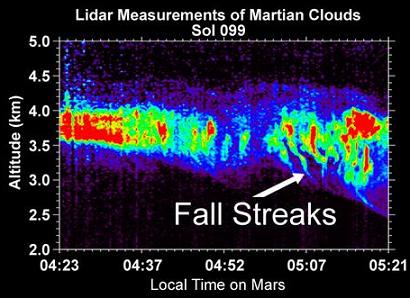This article is more than 1 year old
Phoenix sees snow above Mars, but it's not sticking
Boffins dreaming of white Xmas at Martian North Pole
NASA's Phoenix lander has detected snow falling from Martian clouds, hinting that liquid water may once have been common on the surface of the Red Planet. However, the snow seen by the explorer robot didn't merely turn to rain as it fell - it vapourised, never even reaching the ground at all.

Do robots dream of a white light-blue-shading-to-purple Christmas?
"Nothing like this view has ever been seen on Mars," said Jim Whiteway, of York University in Toronto, speaking of the results obtained by the Meteorological Station on the Phoenix. The Station is Canadian supplied.
It seems that the interplanetary Earthling probe-droid has also found signs of calcium carbonate and possible clay at its landing site in the plains of the Vastitas Borealis, close to the Martian North Pole. Carbonates and clay on Earth normally form in the presence of water.
"We have found carbonate," rejoiced William Boynton of the University of Arizona, lead scientist for the Thermal and Evolved Gas Analyzer (TEGA), a major piece of kit in Phoenix's armoury.
"This points toward episodes of interaction with water in the past."
Excited earthling boffinry chiefs hope for yet more revelations from the far-flung polar probe. However they are in a race against the onset of autumnal gloom on the arctic dune seas of the Vastitas Borealis. The solar-powered lander is already well beyond its expected service life.
"For nearly three months after landing, the sun never went below the horizon at our landing site," said Barry Goldstein, NASA interplanetary robo-probo chief.
"Now it is gone for more than four hours each night, and the output from our solar panels is dropping each week. Before the end of October, there won't be enough energy to keep using the robotic arm."
If the probe can just hold on long enough, Whiteway reckons that Phoenix might even detect snow reaching the Red Planet's surface before it finally conks out. The Canadian scientist is plainly hoping for a white Christmas at the Martian North Pole.
There's more from NASA here. ®
